datagridview控件使用方法
datagridveiw getfirstrow的用法

datagridveiw getfirstrow的用法DataGridView.GetFirstRow() 方法用于获取DataGridView 控件中的第一行。
在本文中,我们将逐步回答与该方法相关的问题,以帮助读者更好地理解其用法和功能。
1. DataGridView 控件简介在介绍DataGridView.GetFirstRow() 方法之前,我们首先了解一下DataGridView 控件。
DataGridView 控件是Windows 窗体应用程序中最常用的数据显示控件之一。
它提供了一个灵活和强大的界面来展示和编辑数据表格。
2. DataGridView.GetFirstRow() 方法简介DataGridView.GetFirstRow() 方法是一个实例方法,用于获取DataGridView 控件中的第一行。
它返回一个DataGridViewRow 对象,该对象表示控件中的第一行。
3. 获取第一行的用途和场景在开发应用程序时,经常需要对DataGridView 控件中的数据进行操作。
获取第一行可以帮助我们实现以下功能:- 快速访问表格数据的第一行,以便进行某些特定处理,如删除或编辑。
- 将第一行作为默认选中的行,以提供更好的用户体验。
- 根据第一行的内容设置其他控件的属性或状态,以便与数据的首条记录相关联。
4. 使用DataGridView.GetFirstRow() 方法下面我们将逐步演示如何在代码中使用DataGridView.GetFirstRow() 方法。
# 4.1 准备工作首先,我们需要在Windows 窗体应用程序中添加一个DataGridView 控件,并将其与数据源绑定。
可以通过设计器或者在代码中动态创建DataGridView 控件。
# 4.2 在按钮点击事件中使用GetFirstRow 方法假设我们有一个按钮,点击按钮时将对第一行进行一些特殊处理。
我们可以在按钮的点击事件中使用GetFirstRow 方法来获取第一行,并对其进行处理。
datagridview用法

DataGridView用法1.概述D a ta Gr id Vi ew是Wi n do ws Fo rm s中一种常用的控件,用于展示和编辑表格数据。
本文将介绍Da ta Gr id Vi ew的基本用法和常用功能。
2.基本用法2.1创建D a t a G r i d V i e w要使用D at aG ri dVi e w,首先需要在窗体上进行控件的创建和初始化。
可以通过拖拽控件到窗体上或者在代码中动态创建控件。
2.2数据绑定在D at aG ri dV ie w中展示数据通常需要进行数据绑定。
可以通过设置D a ta So ur ce属性来实现数据绑定,可以绑定Da ta Ta bl e、B i nd in gS ou rc e等数据源。
2.3列定义可以通过列定义来指定D at aG ri dV ie w中的列数、列名、列类型等属性。
可以使用Da ta Gr i dV ie w的Co lu mns集合来对列进行操作。
2.4行操作可以通过Da ta Gr idV i ew的R ow s集合对行进行操作,如添加、删除、插入等操作。
可以根据行索引或行对象进行操作。
3.常用功能3.1样式设置可以通过设置Da ta Gr i dV ie w的Ce ll Sty l e、C o lu mn He ad er De fau l tC el lS ty le、R ow H ea de rs De fa ul tCe l lS ty le等属性来设置样式,如背景色、字体、对齐方式等。
3.2单元格编辑D a ta Gr id Vi ew可以方便地对单元格进行编辑,可以根据需要设置单元格的可编辑性,只读属性等。
可以通过事件处理程序来实现特定单元格的编辑操作。
3.3排序和筛选D a ta Gr id Vi ew提供了对数据进行排序和筛选的功能。
可以通过设置A l lo wS or ti ng属性来启用排序功能,通过设置A l lo wU se rT oF il ter C ol um ns属性来启用筛选功能。
C#DataGridView控件选中行获取其值

C#DataGridView控件选中⾏获取其值DataGridView的⼏个基本操作:1、获得某个(指定的)单元格的值:dataGridView1.Row[i].Cells[j].Value;2、获得选中的总⾏数:dataGridView1.SelectedRows.Count;3、获得当前选中⾏的索引:dataGridView1.CurrentRow.Index;4、获得当前选中单元格的值:dataGridView1.CurrentCell.Value;5、取选中⾏的数据string[] str = new string[dataGridView.Rows.Count];for(int i;i<dataGridView1.Rows.Count;i++){if(dataGridView1.Rows[i].Selected == true){str[i] = dataGridView1.Rows[i].Cells[1].Value.ToString();}}7、获取选中⾏的某个数据int a = dataGridView1.SelectedRows.Index;dataGridView1.Rows[a].Cells[“你想要的某⼀列的索引,想要⼏就写⼏”].Value;获得某个(指定的)单元格的值: dataGridView1.Row[i].Cells[j].Value; Row[i] 应该是Rows[i]int a=dataGridView1.CurrentRow.Index;string str=dataGridView1.Row[a].Cells[“strName”].Value.Tostring();selectedRows[0]当前选中的⾏.cell[列索引].values 就是当前选中⾏的某个单元格的值DataGridView1.SelectedCells(0).Value.ToString 取当前选择单元内容DataGridView1.Rows(e.RowIndex).Cells(2).Value.ToString 当前选择单元第N列内容————————————————版权声明:本⽂为CSDN博主「Mrchai521」的原创⽂章,遵循CC 4.0 BY-SA版权协议,转载请附上原⽂出处链接及本声明。
c#WinForm开发DataGridView控件的各种操作总结(单元格操作,属性设置)
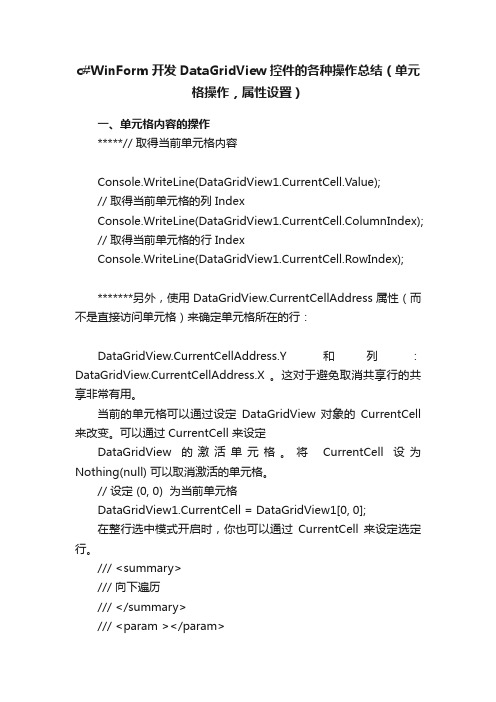
c#WinForm开发DataGridView控件的各种操作总结(单元格操作,属性设置)一、单元格内容的操作*****// 取得当前单元格内容Console.WriteLine(DataGridView1.CurrentCell.Value);// 取得当前单元格的列 IndexConsole.WriteLine(DataGridView1.CurrentCell.ColumnIndex);// 取得当前单元格的行 IndexConsole.WriteLine(DataGridView1.CurrentCell.RowIndex);*******另外,使用 DataGridView.CurrentCellAddress 属性(而不是直接访问单元格)来确定单元格所在的行:DataGridView.CurrentCellAddress.Y 和列:DataGridView.CurrentCellAddress.X 。
这对于避免取消共享行的共享非常有用。
当前的单元格可以通过设定DataGridView 对象的CurrentCell 来改变。
可以通过 CurrentCell 来设定DataGridView 的激活单元格。
将CurrentCell 设为Nothing(null) 可以取消激活的单元格。
// 设定 (0, 0) 为当前单元格DataGridView1.CurrentCell = DataGridView1[0, 0];在整行选中模式开启时,你也可以通过CurrentCell 来设定选定行。
/// <summary>/// 向下遍历/// </summary>/// <param ></param>/// <param ></param>private void button4_Click(object sender, EventArgs e)...{int row = this.dataGridView1.CurrentRow.Index + 1;if (row > this.dataGridView1.RowCount - 1)row = 0;this.dataGridView1.CurrentCell = this.dataGridView1[0, row];}/// <summary>/// 向上遍历/// </summary>/// <param ></param>/// <param ></param>private void button5_Click(object sender, EventArgs e)...{int row = this.dataGridView1.CurrentRow.Index - 1;if (row < 0)row = this.dataGridView1.RowCount - 1;this.dataGridView1.CurrentCell = this.dataGridView1[0, row];}* 注意: this.dataGridView 的索引器的参数是: columnIndex, rowIndex 或是 columnName, rowIndex这与习惯不同。
DATAGRIDVIEW属性及方法

DATAGRIDVIEW属性及方法属性:1. AllowUserToAddRows:获取或设置一个值,指示是否允许用户添加新行。
2. AllowUserToDeleteRows:获取或设置一个值,指示是否允许用户删除行。
3. AllowUserToResizeColumns:获取或设置一个值,指示是否允许用户调整列的大小。
4. AllowUserToResizeRows:获取或设置一个值,指示是否允许用户调整行的大小。
5. AutoSizeColumnsMode:获取或设置值,指示列宽度的调整模式。
6. DataSource:获取或设置与该DataGridView关联的数据源。
7. RowHeadersVisible:获取或设置一个值,指示是否显示行标题。
8. ColumnHeadersVisible:获取或设置一个值,指示是否显示列标题。
9. ReadOnly:获取或设置一个值,指示是否只读。
10. MultiSelect:获取或设置一个值,指示是否可以同时选择多个单元格。
方法:1. ClearSelection(:取消选择所有选定的单元格。
2. Refresh(:重新绘制DataGridView控件。
3. Sort(DataGridViewColumn, ListSortDirection):按指定的列和排序顺序对表格进行排序。
4. SelectAll(:选择所有单元格。
5. Clear(:清除掉DataGridView控件中的所有数据。
7. ClearSelection(:清除当前选定的单元格的选择。
除了上述属性和方法外,DataGridView还有一些事件,可以让我们在特定的情况下作出响应。
例如,CellClick事件在单击单元格时触发,可以用来获取当前选中的单元格的值。
另外,DataGridView还有许多其他的属性和方法,用于设置和操作表格的样式、行高、列宽等。
总结起来,DataGridView是Windows Forms中非常常用的表格控件,具有丰富的属性和方法,用于设置和操作表格的外观和行为。
datagridviewdoubleinputcolumn 小数位数

datagridviewdoubleinputcolumn 小数位数DataGridViewDoubleInputColumn是Windows Forms中的一个控件,它用于在DataGridView控件中显示和编辑带有双精度浮点数(小数)类型数据的列。
本文将详细介绍DataGridViewDoubleInputColumn控件的小数位数设置方法及其使用。
1. DataGridViewDoubleInputColumn控件概述DataGridViewDoubleInputColumn控件是一个数据列控件,用于在DataGridView控件中显示和编辑Double类型的数据。
它提供了一种简便的方法来显示和编辑带有小数位数的Double类型数据。
通过设置小数位数,可以控制数据的显示和编辑格式,使得用户可以更加直观地操作和理解数据。
2. 小数位数的设置设置DataGridViewDoubleInputColumn控件的小数位数可以通过以下步骤进行:步骤一:在项目中添加一个DataGridView控件。
在Visual Studio中,我们可以通过在窗体界面上拖放DataGridView控件的方式来添加一个DataGridView控件。
步骤二:在DataGridView控件中添加一个DataGridViewDoubleInputColumn列。
在设计时,选择DataGridView控件,右键点击选择“编辑列”,然后点击“添加”按钮,选择“DataGridViewDoubleInputColumn”,点击确定按钮,即可在DataGridView控件中添加一个DataGridViewDoubleInputColumn列。
步骤三:设置小数位数在代码中对DataGridViewDoubleInputColumn列进行设置。
可以使用小数位数的设置属性“DecimalPlaces”来指定控件列中的小数位数。
例如,设置小数位数为两位,可以使用以下代码:csharpDataGridViewDoubleInputColumn doubleColumn = (DataGridViewDoubleInputColumn)dataGridView1.Columns[0]; doubleColumn.DecimalPlaces = 2;通过这样的设置,DataGridViewDoubleInputColumn列的数据将以两位小数的格式进行显示和编辑。
vb6 datagridview控件用法

一、VB6简介Visual Basic 6.0(VB6)是微软公司于1998年推出的一款集成开发环境(IDE),是一种基于事件驱动的第三代事件驱动语言。
它允许开发者以快速、简单的方式创建Windows应用程序。
VB6具有可视化编程的特点,允许开发者以拖拽控件的方式构建界面,极大地提高了开发效率。
二、DataGridView控件概述DataGridView控件是VB6中用于显示和编辑数据的控件,它提供了功能强大的数据表格展示能力,可以实现类似Excel表格的功能。
它是VB6中用于数据展示的重要控件之一,具有灵活性高、界面友好等特点。
三、DataGridView控件的基本用法使用DataGridView控件展示数据一般需要以下步骤:1. 在VB6的工具箱中找到DataGridView控件,将其拖拽到窗体中。
2. 设置数据源:可以通过ADODB连接数据库,或者手动添加数据到DataGridView中。
3. 配置列:可以设置每一列的名称、宽度、颜色等属性。
4. 对DataGridView进行一些基本的样式调整,比如添加边框、更换背景颜色等。
四、DataGridView控件的高级用法除了基本的展示功能外,DataGridView控件还支持一些高级用法,比如:1. 数据编辑:可以在DataGridView中实现对数据的增删改操作,通过单元格的编辑功能实现数据的实时更新。
2. 数据筛选:可以根据条件对数据进行筛选,实现灵活的数据展示。
3. 数据导出:可以将DataGridView中的数据导出为Excel表格或者其他格式的文件。
4. 事件处理:可以通过DataGridView的事件来监听用户的操作,比如单元格的点击、双击等操作。
五、DataGridView控件的注意事项在使用DataGridView控件时需要注意一些问题,比如:1. 对数据源的操作需要小心,避免出现数据同步问题。
2. 对于大量数据的展示,需要注意性能优化,避免出现卡顿现象。
DataGridView控件操作大全(内容居中显示,右键绑定菜单)

DataGridView控件操作⼤全(内容居中显⽰,右键绑定菜单)DataGridView1.ColumnHeadersDefaultCellStyle.Alignment = DataGridViewContentAlignment.MiddleCenter '标题居中DataGridView1.RowsDefaultCellStyle.Alignment = DataGridViewContentAlignment.MiddleCenter '内容居中this.dataGridView1.AutoGenerateColumns = false; //让它不⾃⼰产⽣多余的列// this.dataGridView1.AutoSizeColumnsModel = Fill //列名占满容器this.dataGridView1.AutoSizeColumnsModel = AllCells //列名占满容器#region [DataGridView控件单元格点击事件,绑定右键菜单]private void dataGridView_Score_CellClick(object sender, DataGridViewCellEventArgs e){if (e.RowIndex > -1){//绑定右键菜单dataGridView_Score.SelectedRows[0].ContextMenuStrip = this.contextMenuStrip1;}}#endregionDataGridView单元格内容显⽰格式化:代⼊Dictionary<string,string>⽅法private void dataGridView_Score_CellFormatting(object sender, DataGridViewCellFormattingEventArgs e){Dictionary<string,string> scoreStatus = GetScoreStatus();if (e.ColumnIndex == 7){e.Value = scoreStatus[e.Value.ToString()];e.FormattingApplied = true;}}#region [设定ComboBox数据源]private Dictionary<string, string> GetScoreStatus(){Dictionary<string, string> dic = new Dictionary<string, string>{{"2", "全部"},{"1", "成功"},{"0", "失败"}};return dic;}#endregion获取DataGridView选中数据, 返回对象:#region[获取DataGridView的选中⾏数据]/// <summary>/// 获取当前选中⾏的数据/// </summary>/// <returns>当前选中⾏数据</returns>private JudgeSetting GetSelectRowInfo(){DataGridViewRow selectRows = dataGridView_Judge.SelectedRows[0];JudgeSetting setting = new JudgeSetting();if (selectRows != null){// 项⽬代码setting.Ksxmdm = Convert.ToInt32(selectRows.Cells["项⽬代码"].Value);// 项⽬名称setting.Gakfmc = Convert.ToString(selectRows.Cells["项⽬名称"].Value);}return setting;}#endregion替换DataGridView头部显⽰,#region[替换DataTable头]/// <summary>/// 替换DataTable头/// </summary>/// <param name="dt">查询出的DataTable</param>/// <returns></returns>private DataTable ReplaceDataTableHead(DataTable dt){dt.Columns[0].ColumnName = "项⽬代码";dt.Columns[1].ColumnName = "项⽬名称";dt.Columns[2].ColumnName = "扣分项⽬";return dt;}#endregion#region[DataTable样式调整]/// <summary>/// DataTable样式调整/// </summary>private void ChangeDataTableStyle(){// KEY列隐藏this.dataGridView_Judge.Columns[10].Visible = false;this.dataGridView_Judge.Columns[9].Visible = false;//this.dataGridView_Judge.Columns[0].Width = 80;//this.dataGridView_Judge.Columns[1].Width = 100;this.dataGridView_Judge.Columns[0].AutoSizeMode = DataGridViewAutoSizeColumnMode.AllCells; }#endregion绑定dataTable到DataGridView#region[绑定dataTable到DataGridView]/// <summary>/// 绑定dataTable到DataGridView/// </summary>/// <param name="dt">源DataTable</param>private void BindDataTble(DataTable dt){if (toolStripComboBox1.Text != "全部"){DataRow[] rows = dt.Select(string.Format("GAKFMC = '{0}'", toolStripComboBox1.Text));DataTable table = dt.Clone();foreach(DataRow row in rows){table.Rows.Add(row.ItemArray);}dt = table;}// 修改DataTable头部dt = ReplaceDataTableHead(dt);// 绑定数据this.dataGridView_Judge.DataSource = dt;// 修改DataTable样式ChangeDataTableStyle();// 刷新读取的条数this.toolStripLabel4.Text = dt.Rows.Count.ToString();}#endregion刷新DataGridView的绑定#region[刷新DataGridView的绑定]/// <summary>/// 刷新DataGridView的绑定/// </summary>/// <param name="sqlEnum">查询语句</param>private void RefreshBindTable(SqlStatusEnum sqlEnum){try{DataTable dt = QueryData(sqlEnum, null);if (dt != null && dt.Rows.Count > 0){BindDataTble(dt);}elseMessageBox.Show("查询错误,或未查询到相关数据!");}catch (Exception ex){LogHelper.Error(ex);}}#endregionDataGridView控件绑定List<string> List<Student> strList = new List<Student>(){new Student(){StuId = 1, StuName = "张三"},new Student(){StuId = 2, StuName = "李四"},new Student(){StuId = 3, StuName = "王五"}};//查找出ID,并显⽰姓名,List<{m}>绑定到datagridview,可以把m去掉,.Select(m => new { m.StuName })这样展⽰就是StuName的列名 var students = strList.Where(s =>s.StuId == 2).Select(m => new { m = m.StuName }).ToList();dataGridView1.DataSource = students; //显⽰出以m为列名的数据,可以⼿动修改列名将dataGridView选定的⾏转换为实体对象ContactModel model = dataGridView1.CurrentRow.DataBoundItem as ContactModel;。
datagridview中的refresh方法

datagridview中的refresh方法
datagridview控件的refresh(方法用于更新控件中的数据。
它同时刷新数据表中所有字段的内容,以便最新的数据及时出现在屏幕上。
如果你的应用程序当中有显示最新数据的需求,你可以使用DataGridView控件的Refresh(方法来实现。
DataGridView控件的Refresh(方法可以实现一下功能:
1、更新datagridview中所有显示的字段,包括新增和删除的字段内容;
2、更新数据表中的数据,所有的数据行,包括新增和更新的字段内容;
3、刷新当前行,显示最新的行内容;
4、刷新列,显示最新的列内容;
5、刷新指定的行或列,显示最新的元素内容;
使用DataGridView控件的Refresh(方法来更新显示的数据是很容易的,只需要在调用Refresh(方法时,传入更新的范围就可以了。
比如可以传入的参数为:“all”,表示更新整个数据表;“row”,表示更新当前行;“column”,表示更新当前列;“row,column”,表示更新当前行和列;“custom”,表示只更新指定的行或列,由用户自己指定行或列。
DataGridView控件的Refresh(方法是一种非常有用的技术,可以帮助开发人员更新数据表中的数据。
datagridveiw getfirstrow的用法 -回复
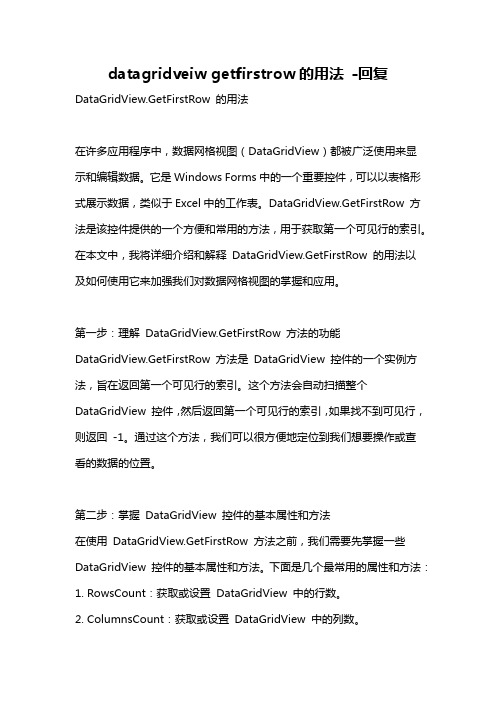
datagridveiw getfirstrow的用法-回复DataGridView.GetFirstRow 的用法在许多应用程序中,数据网格视图(DataGridView)都被广泛使用来显示和编辑数据。
它是Windows Forms中的一个重要控件,可以以表格形式展示数据,类似于Excel中的工作表。
DataGridView.GetFirstRow 方法是该控件提供的一个方便和常用的方法,用于获取第一个可见行的索引。
在本文中,我将详细介绍和解释DataGridView.GetFirstRow 的用法以及如何使用它来加强我们对数据网格视图的掌握和应用。
第一步:理解DataGridView.GetFirstRow 方法的功能DataGridView.GetFirstRow 方法是DataGridView 控件的一个实例方法,旨在返回第一个可见行的索引。
这个方法会自动扫描整个DataGridView 控件,然后返回第一个可见行的索引,如果找不到可见行,则返回-1。
通过这个方法,我们可以很方便地定位到我们想要操作或查看的数据的位置。
第二步:掌握DataGridView 控件的基本属性和方法在使用DataGridView.GetFirstRow 方法之前,我们需要先掌握一些DataGridView 控件的基本属性和方法。
下面是几个最常用的属性和方法:1. RowsCount:获取或设置DataGridView 中的行数。
2. ColumnsCount:获取或设置DataGridView 中的列数。
3. VisibleRowsCount:获取DataGridView 中可见的行数。
4. VisibleColumnsCount:获取DataGridView 中可见的列数。
5. GetRowVisibleState 方法:获取指定行的可见状态,返回一个布尔值。
6. GetColumnVisibleState 方法:获取指定列的可见状态,返回一个布尔值。
DataGridView 行、列的隐藏和删除
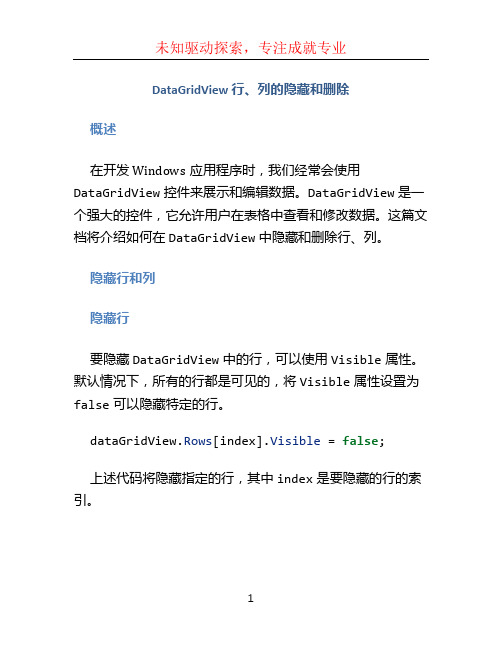
DataGridView 行、列的隐藏和删除概述在开发Windows应用程序时,我们经常会使用DataGridView控件来展示和编辑数据。
DataGridView是一个强大的控件,它允许用户在表格中查看和修改数据。
这篇文档将介绍如何在DataGridView中隐藏和删除行、列。
隐藏行和列隐藏行要隐藏DataGridView中的行,可以使用Visible属性。
默认情况下,所有的行都是可见的,将Visible属性设置为false可以隐藏特定的行。
dataGridView.Rows[index].Visible = false;上述代码将隐藏指定的行,其中index是要隐藏的行的索引。
要隐藏DataGridView中的列,可以使用Visible属性。
默认情况下,所有的列都是可见的,将Visible属性设置为false可以隐藏特定的列。
dataGridView.Columns[index].Visible = false;上述代码将隐藏指定的列,其中index是要隐藏的列的索引。
删除行和列删除行要删除DataGridView中的行,可以使用RemoveAt方法。
该方法将从DataGridView的行集合中删除指定索引的行。
dataGridView.Rows.RemoveAt(index);上述代码将删除指定索引的行,其中index是要删除的行的索引。
要删除DataGridView中的列,可以使用RemoveAt方法。
该方法将从DataGridView的列集合中删除指定索引的列。
dataGridView.Columns.RemoveAt(index);上述代码将删除指定索引的列,其中index是要删除的列的索引。
示例下面的示例演示了如何在DataGridView中隐藏和删除行、列。
// 隐藏行dataGridView.Rows[0].Visible = false;// 隐藏列dataGridView.Columns[1].Visible = false;// 删除行dataGridView.Rows.RemoveAt(2);// 删除列dataGridView.Columns.RemoveAt(3);上述代码将隐藏第一行、第二列,并删除第三行和第四列。
datagridview多维表头的实现方法

datagridview是C#中常用的数据控件之一,它在WinForm中可以方便地显示和编辑数据。
在实际开发中,经常会遇到需要在datagridview中实现多维表头的需求,即需要在列头或行头上显示多级标题。
下面我们将介绍一些实现datagridview多维表头的方法。
1. 使用表头合并实现多维表头datagridview控件提供了表头合并的功能,可以通过设置列或行的合并来实现多维表头。
这种方法的优点是简单易实现,但缺点是不够灵活,只能通过合并固定的行和列来实现多维表头。
2. 自定义表头绘制实现多维表头通过自定义datagridview的表头绘制事件,可以实现灵活的多维表头。
在表头绘制事件中,可以根据需要绘制多级标题,并进行样式设置。
这种方法的优点是灵活性高,可以满足各种多维表头的需求,但缺点是实现相对复杂,需要对datagridview的绘制机制有一定的了解。
3. 使用第三方控件实现多维表头除了自带的datagridview控件外,也可以使用第三方控件来实现多维表头。
一些第三方控件库提供了更丰富的表格控件,可以轻松实现多维表头。
但是需要注意的是,引入第三方控件可能会增加项目的复杂性和依赖性。
通过以上介绍,我们可以看出实现datagridview多维表头有多种方法,选择合适的方法需要根据实际需求和项目情况进行权衡。
在实际开发中,我们可以根据具体情况选择合适的方法来实现多维表头,以便更好地展示和管理数据。
希望以上内容对大家有所帮助。
实现datagridview多维表头的方法在实际开发中有着重要的应用意义,尤其是在需要展示复杂数据关系和多层级信息的情况下。
在本文中,我们将继续探讨datagridview多维表头的实现方法,并详细阐述每种方法的具体步骤和应用场景。
1. 使用表头合并实现多维表头表头合并是实现datagridview多维表头的一种基本方法。
通过合并列或行,实现多级标题的显示。
这种方法适合于表头结构相对固定或层级较少的场景。
datagridview 用法
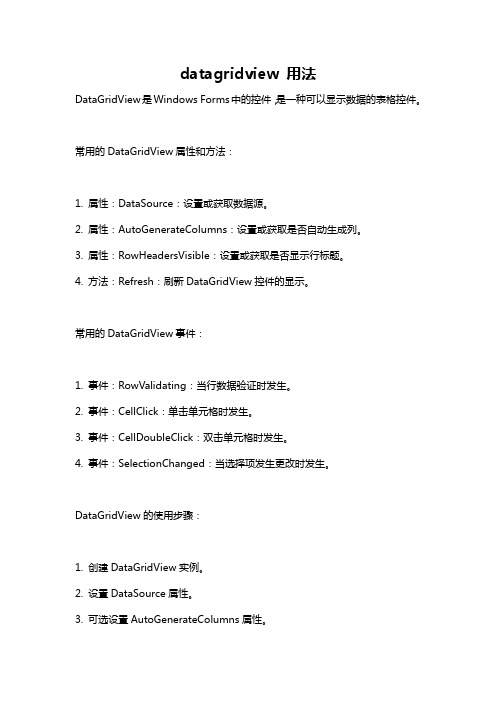
datagridview 用法DataGridView是Windows Forms中的控件,是一种可以显示数据的表格控件。
常用的DataGridView属性和方法:1. 属性:DataSource:设置或获取数据源。
2. 属性:AutoGenerateColumns:设置或获取是否自动生成列。
3. 属性:RowHeadersVisible:设置或获取是否显示行标题。
4. 方法:Refresh:刷新DataGridView控件的显示。
常用的DataGridView事件:1. 事件:RowValidating:当行数据验证时发生。
2. 事件:CellClick:单击单元格时发生。
3. 事件:CellDoubleClick:双击单元格时发生。
4. 事件:SelectionChanged:当选择项发生更改时发生。
DataGridView的使用步骤:1. 创建DataGridView实例。
2. 设置DataSource属性。
3. 可选设置AutoGenerateColumns属性。
4. 可选设置RowHeadersVisible属性及其他属性。
5. 注册事件处理程序。
6. 添加DataGridView到窗体中。
下面是一个简单示例代码:C#代码:csharpdataGridView1.DataSource = dataTable; dataTable为绑定数据源dataGridView1.AutoGenerateColumns = true;dataGridView1.RowHeadersVisible = false;dataGridView1.CellClick += DataGridView_CellClick;注:DataGridView_CellClick是事件处理程序的方法名,需要自行定义。
C#中DataGridView的使用
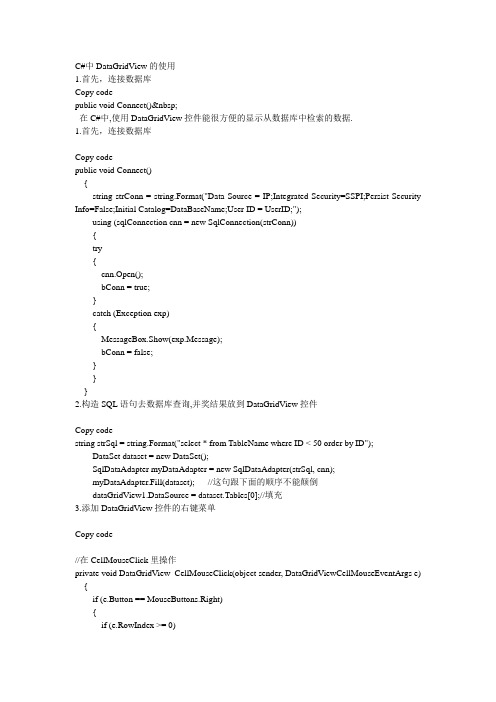
{
try
{
cnn.Open();
bConn = true;
}
catch (Exception exp)
{
MessageBox.Show(exp.Message);
bConn = false;
}
dataGridView1.Columns[1].FillWeight = 15;
dataGridView1.Columns[2].FillWeight = 15;
dataGridView1.Columns[3].FillWeight = 8;
dataGridView1.Columns[4].FillWeight = 50;
i += 2;
}
}
dataGridView1.Columns[5].FillWeight = 4;
//设置标题文字
dataGridView1.Columns[0].HeaderText = "A";
dataGridView1.Columns[1].HeaderText = "B";
dataGridView1.Columns[2].HeaderText = "C";
{
if (e.RowIndex >= 0)
{
dataGridView1.ClearSelection();
dataGridView1.Rows[e.RowIndex].Selected = true; //选中
dataGridView1.CurrentCell = dataGridView1.Rows[e.RowIndex].Cells[e.ColumnIndex];//选中单元
winformdatagridview.sort用法

winformdatagridview.sort用法在WinForm应用程序中,DataGridView控件是一个常用的数据展示组件。
为了方便用户对数据进行排序,我们可以使用DataGridView的Sort方法。
本文将介绍WinFormDataGridview.Sort的用法。
一、Sort方法概述Sort方法用于对DataGridView中的数据进行排序。
它接受一个字符串参数,指定要排序的列的名称。
默认情况下,Sort方法按照升序排序数据。
如果需要按照降序排序,可以使用自定义比较器或实现IComparer接口。
二、Sort用法示例以下是一个简单的WinForm应用程序,其中包含一个DataGridView控件,用于展示数据并允许用户进行排序。
首先,需要在设计器中添加一个DataGridView控件,并设置DataSource和Sortable属性以启用排序功能。
接下来,在代码中实现Sort方法的用法。
以下是一个简单的示例:```csharp//假设DataGridView控件名为dataGridView1,数据源为dataListDataGridViewColumncolumn=dataGridView1.Columns["ColumnName"];//指定要排序的列名dataGridView1.Sort(column,ponentModel.ListSortDirection.A scending);//按照升序排序//实现自定义比较器进行降序排序publicclassCustomComparer:IComparer{publicintCompare(objectx,objecty){//根据需要实现自定义比较逻辑//返回负值表示x小于y,返回正值表示x大于y,返回0表示x等于y}}//在需要排序时调用Sort方法,传入自定义比较器对象dataGridView1.Sort(column,newCustomComparer());//按照降序排序```三、注意事项在使用Sort方法时,需要注意以下几点:1.确保DataGridView控件的DataSource属性已设置,以便从数据源获取数据。
sunnyui datagridview详细用法

sunnyui datagridview详细用法DataGridView是Windows Forms中的一个常用的控件,用于显示和编辑数据。
它提供了直观、易于使用的界面,用于显示和编辑表格数据。
在SunnyUI框架中,DataGridView控件提供了许多方便的功能和选项,使得数据展示更加方便。
本文将详细介绍SunnyUI框架中的DataGridView控件的用法。
一、DataGridView控件简介DataGridView控件提供了一种方便的方式来显示和编辑数据,它允许用户通过简单的鼠标操作进行选择和编辑数据。
DataGridView控件还提供了许多功能,如行高、列宽的自动调整、分页、排序、筛选等。
这些功能使得DataGridView控件在各种应用程序中都非常有用。
二、DataGridView控件属性设置在使用DataGridView控件之前,我们需要设置一些属性来控制其外观和行为。
以下是一些常用的属性及其说明:1. AutoGenerateColumns:决定是否自动生成列头和列索引。
默认为True,即自动生成列头和列索引。
2. AllowUserToAddRows:是否允许用户添加行。
默认为True。
3. AllowUserToDeleteRows:是否允许用户删除行。
默认为True。
4. RowHeights:行的高度设置。
可以通过设置此属性来改变行的高度。
5. ColumnCount和Columns:设置列的数量和名称。
可以设置多个列的名称和属性。
三、DataGridView控件数据绑定将DataGridView控件绑定到数据源是使用DataGridView控件的关键步骤之一。
可以使用以下方法将数据绑定到DataGridView控件:1. 使用DataSource属性将数据绑定到DataGridView控件。
可以将DataSet、DataTable或自定义对象集合绑定到DataGridView控件。
操作DataGridView控件详解

在项目中,老程序员都知道显示数据的控件的操作灵活性很重要。
Visual Studio 2008里面提供了一个很强大的数据显示控件------------DataGridView。
DataGrid View与VB、VC中的DataGrid控件功能很相似,但比起更加强大,操作更灵活,废话不说了。
操作DataGridView有两种方式,一种是使用控件绑定的方式,操作的时候只要更改DataSet控件的数据集就能够实现DataGridView数据的灵活显示;另一种方式是全部使用代码来手工操作DataGridView控件的显示,尽量少用控件,使代码看起来更连贯,操作更灵活。
控件方法来操作DataGridView控件:(控件方法略,比较简单,拖控件,绑定即可)代码方法来操作DataGridView控件通过上两节,老程序员对数据的简单操作已经很熟练了。
现在在第一个实例“hello word!”的基础上,继续DataGridView控件的手工操作实习。
添加一个控件,文本命名如图:我们在上面看到的数据显示时这样的:列的头部是数据库表的列段名,因为我们是将SQL查询的数据集直接绑定到DataGridView控件的。
下来我们来改变它的头部,同时,来指定DataGridView控件各个列绑定的数据成员。
private void button4_Click(object sender, EventArgs e){//定义数据库连接字符string str_con = @"Data Source=26-3B72903E783B\SQLEXPRESS;Integrated Security=SS PI;Initial Catalog=testDB;";//定义SQL语句字符串string sql = "select * from danwei";// string sql = string.Format("insert into danwei (danwei) values ('{0}')", text Box1.Text);//定义并实例化数据库连接类型变量SqlConnection conn = new SqlConnection(str_con);//打开数据库连接conn.Open();SqlCommand comm = new SqlCommand(sql, conn);SqlDataAdapter da = new SqlDataAdapter(comm);DataSet ds = new DataSet();da.Fill(ds, "danwei");dataGridView1.DataSource = ds;dataGridView1.DataMember = "danwei";//---------------以上代码可以直接拷贝button3的代码--------------------//设置dataGridView1控件第一列的列头文字dataGridView1.Columns[0].HeaderText = "序号";//设置dataGridView1控件第一列的列宽dataGridView1.Columns[0].Width = 80;//设置dataGridView1控件第二列的列头文字dataGridView1.Columns[1].HeaderText = "单位";//设置dataGridView1控件第二列绑定的数据集中第一个数据表的第二列的数据//前面说了,ds数据集是一个多表的集合dataGridView1.Columns[1].DataPropertyName = ds.Tables[0].Columns[1].ToString();//设置dataGridView1控件第二列的列宽dataGridView1.Columns[1].Width = 300;conn.Close();}运行后,按下DataGridViewOpar按钮显示如下:比较原来的;发现就是列头变了,以及下面的滚动条长了,其实数据绑定了。
winform datagridview控件用法

winform datagridview控件用法Winform DataGridView 控件用法详解一、简介Winform DataGridView 控件是 .NET Framework 中提供的一个强大的数据显示和编辑控件。
它可以显示和编辑多种类型的数据(如文本、数字、日期、图像等),并且提供了丰富的功能和灵活的样式设置,可以方便地实现数据的展示、排序、筛选、编辑、分页等操作。
二、绑定数据源1. 绑定数据集可以通过设置DataGridView 的DataSource 属性来绑定一个数据集(DataSet)或数据表(DataTable)。
在Visual Studio 的设计器中,通过选择数据源和数据成员来实现绑定,也可以通过代码实现。
例如:dataGridView1.DataSource = dataSet.Tables["TableName"];2. 绑定数据集合除了绑定数据集,还可以绑定数据集合(如List<T>、BindingList<T> 等)。
在数据集合发生变化时,DataGridView 会自动更新显示的数据。
例如:List<User> userList = new List<User>();dataGridView1.DataSource = userList;3. 动态绑定数据绑定数据源后,可以通过设置DataGridView 的AutoGenerateColumns 属性为true,自动根据数据源的结构创建列。
也可以通过手动添加列来控制显示的列数和顺序。
例如:dataGridView1.AutoGenerateColumns = true;三、设置列样式1. 自动调整列宽可以通过设置DataGridView 的AutoSizeColumnsMode 属性来调整列宽。
通常选择AllCells 或Fill,前者会根据列中的内容调整列宽,后者会填充整个控件。
winformdatagridview.sort用法 -回复

winformdatagridview.sort用法-回复WinForm中的DataGridView控件是用来显示和编辑表格数据的常用控件,而Sort方法则是用来对DataGridView中的数据进行排序的方法。
本文将一步一步地介绍如何使用Sort方法对DataGridView控件进行排序。
第一步:创建WinForm应用程序并添加DataGridView控件首先,在Visual Studio中创建一个新的WinForm应用程序。
然后,在应用程序的界面中添加一个DataGridView控件。
你可以通过在工具箱中找到DataGridView控件,然后将其拖放到你的窗体上。
第二步:绑定数据源接下来,我们需要将数据源绑定到DataGridView控件上。
你可以使用任何你喜欢的数据源,例如DataSet、DataTable、List等。
在本文中,我们将使用一个DataTable作为数据源。
首先,在Form的Load事件中创建一个新的DataTable,并向其中添加一些样本数据。
然后,将DataTable设置为DataGridView的数据源。
csharpprivate void Form1_Load(object sender, EventArgs e){DataTable dt = new DataTable();dt.Columns.Add("Name");dt.Columns.Add("Age");dt.Rows.Add("John", 25);dt.Rows.Add("Michael", 30);dt.Rows.Add("Sarah", 18);dataGridView1.DataSource = dt;}第三步:添加排序按钮现在,我们需要添加一个按钮,当用户点击该按钮时,触发DataGridView 的排序操作。
- 1、下载文档前请自行甄别文档内容的完整性,平台不提供额外的编辑、内容补充、找答案等附加服务。
- 2、"仅部分预览"的文档,不可在线预览部分如存在完整性等问题,可反馈申请退款(可完整预览的文档不适用该条件!)。
- 3、如文档侵犯您的权益,请联系客服反馈,我们会尽快为您处理(人工客服工作时间:9:00-18:30)。
DataGridView动态添加新行:DataGridView控件在实际应用中非常实用,特别需要表格显示数据时。
可以静态绑定数据源,这样就自动为DataGridView控件添加相应的行。
假如需要动态为DataGridView控件添加新行,方法有很多种,下面简单介绍如何为DataGridView控件动态添加新行的两种方法:方法一:int index=this.dataGridView1.Rows.Add();this.dataGridView1.Rows[index].Cells[0].Value = "1";this.dataGridView1.Rows[index].Cells[1].Value = "2";this.dataGridView1.Rows[index].Cells[2].Value = "监听";利用dataGridView1.Rows.Add()事件为DataGridView控件增加新的行,该函数返回添加新行的索引号,即新行的行号,然后可以通过该索引号操作该行的各个单元格,如dataGridView1.Rows[index].Cells[0].Value = "1"。
这是很常用也是很简单的方法。
方法二:DataGridViewRow row = new DataGridViewRow();DataGridViewTextBoxCell textboxcell = new DataGridViewTextBoxCell();textboxcell.Value = "aaa";row.Cells.Add(textboxcell);DataGridViewComboBoxCell comboxcell = new DataGridViewComboBoxCell();row.Cells.Add(comboxcell);dataGridView1.Rows.Add(row);方法二比方法一要复杂一些,但是在一些特殊场合非常实用,例如,要在新行中的某些单元格添加下拉框、按钮之类的控件时,该方法很有帮助。
DataGridViewRow row = new DataGridViewRow();是创建DataGridView的行对象,DataGridViewTextBoxCell是单元格的内容是个TextBox,DataGridViewComboBoxCell是单元格的内容是下拉列表框,同理可知,DataGridViewButtonCell是单元格的内容是个按钮,等等。
textboxcell是新创建的单元格的对象,可以为该对象添加其属性。
然后通过row.Cells.Add(textboxcell)为row对象添加textboxcell单元格。
要添加其他的单元格,用同样的方法即可。
最后通过dataGridView1.Rows.Add(row)为dataGridView1控件添加新的行row。
DataGridView取得或者修改当前单元格的内容:当前单元格指的是DataGridView 焦点所在的单元格,它可以通过DataGridView 对象的CurrentCell 属性取得。
如果当前单元格不存在的时候,返回Nothing(C#是null)// 取得当前单元格内容Console.WriteLine(DataGridView1.CurrentCell.Value);// 取得当前单元格的列IndexConsole.WriteLine(DataGridView1.CurrentCell.ColumnIndex);// 取得当前单元格的行IndexConsole.WriteLine(DataGridView1.CurrentCell.RowIndex);另外,使用DataGridView.CurrentCellAddress 属性(而不是直接访问单元格)来确定单元格所在的行:DataGridView.CurrentCellAddress.Y列:DataGridView.CurrentCellAddress.X 。
这对于避免取消共享行的共享非常有用。
当前的单元格可以通过设定DataGridView 对象的CurrentCell 来改变。
可以通过CurrentCell 来设定DataGridView 的激活单元格。
将CurrentCell 设为Nothing(null) 可以取消激活的单元格。
// 设定(0, 0) 为当前单元格DataGridView1.CurrentCell = DataGridView1[0, 0];在整行选中模式开启时,你也可以通过CurrentCell 来设定选定行。
/// 向下遍历private void button4_Click(object sender, EventArgs e)...{int row = this.dataGridView1.CurrentRow.Index + 1;if (row > this.dataGridView1.RowCount - 1)row = 0;this.dataGridView1.CurrentCell = this.dataGridView1[0, row];}/// 向上遍历private void button5_Click(object sender, EventArgs e)...{int row = this.dataGridView1.CurrentRow.Index - 1;if (row < 0)row = this.dataGridView1.RowCount - 1;this.dataGridView1.CurrentCell = this.dataGridView1[0, row];}* 注意: this.dataGridView 的索引器的参数是: columnIndex, rowIndex 或是columnName, rowIndex这与习惯不同。
DataGridView设定单元格只读:1)使用ReadOnly 属性如果希望,DataGridView 内所有单元格都不可编辑,那么只要:// 设置DataGridView1 为只读DataGridView1.ReadOnly = true;此时,用户的新增行操作和删除行操作也被屏蔽了。
如果希望,DataGridView 内某个单元格不可编辑,那么只要:// 设置DataGridView1 的第2列整列单元格为只读DataGridView1.Columns[1].ReadOnly = true;// 设置DataGridView1 的第3行整行单元格为只读DataGridView1.Rows[2].ReadOnly = true;// 设置DataGridView1 的[0,0]单元格为只读DataGridView1[0, 0].ReadOnly = true;2)使用EditMode 属性DataGridView.EditMode 属性被设置为DataGridViewEditMode.EditProgrammatically 时,用户就不能手动编辑单元格的内容了。
但是可以通过程序,调用DataGridView.BeginEdit 方法,使单元格进入编辑模式进行编辑。
DataGridView1.EditMode = DataGridViewEditMode.EditProgrammatically;3)根据条件设定单元格的不可编辑状态当一个一个的通过单元格坐标设定单元格ReadOnly 属性的方法太麻烦的时候,你可以通过CellBeginEdit 事件来取消单元格的编辑。
// CellBeginEdit 事件处理方法private void DataGridView1_CellBeginEdit(object sender, DataGridViewCellCancelEventArgs e){DataGridView dgv = (DataGridView)sender;//是否可以进行编辑的条件检查if (dgv.Columns[e.ColumnIndex].Name == "Column1" && !(bool)dgv["Column2",e.RowIndex].Value){// 取消编辑e.Cancel = true;}}DataGridView不显示最下面的新行:通常DataGridView 的最下面一行是用户新追加的行(行头显示* )。
如果不想让用户新追加行即不想显示该新行,可以将DataGridView 对象的AllowUserToAddRows 属性设置为False。
// 设置用户不能手动给DataGridView1 添加新行DataGridView1.AllowUserToAddRows = false;但是,可以通过程序:DataGridViewRowCollection.Add 为DataGridView 追加新行。
补足:如果DataGridView 的DataSource 绑定的是DataView, 还可以通过设置DataView.AllowAdd属性为False 来达到同样的效果。
DataGridView判断新增行:DataGridView 的AllowUserToAddRows属性为True时也就是允许用户追加新行的场合下,DataGridView的最后一行就是新追加的行(*行)。
使用DataGridViewRow.IsNewRow 属性可以判断哪一行是新追加的行。
另外,通过DataGridView.NewRowIndex 可以获取新行的行序列号.在没有新行的时候,NewRowIndex = -1。
DataGridView行的用户删除操作的自定义:1)无条件的限制行删除操作。
默认时,DataGridView 是允许用户进行行的删除操作的。
如果设置DataGridView对象的AllowUserToDeleteRows属性为False 时,用户的行删除操作就被禁止了。
// 禁止DataGridView1的行删除操作。
DataGridView1.AllowUserToDeleteRows = false;但是,通过DataGridViewRowCollection.Remove 还是可以进行行的删除。
补足:如果DataGridView 绑定的是DataView 的话,通过DataView.AllowDelete 也可以控制行的删除。
